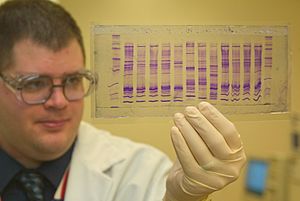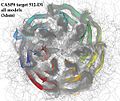Sequence analysis facts for kids
Sequence analysis is a way to figure out the exact order of the tiny building blocks that make up living things. Imagine DNA as a long code made of letters. Sequence analysis finds the order of these letters (called nucleotides) in DNA or RNA. It also finds the order of amino acids in proteins.
This process often uses special machines that can read these sequences very quickly. However, understanding what these sequences mean and how they affect living things still needs smart people to interpret the results. The information from sequence analysis helps scientists learn how different organisms are related to each other, like how closely two types of animals might be connected.
Contents
What is a DNA Sequence?
A DNA sequence is simply the order of the building blocks (nucleotides) in a DNA molecule. Think of it like a secret message written with only four letters: A, C, G, and T. These letters stand for four different chemical bases: adenine, cytosine, guanine, and thymine.
These letters are written one after another, without any spaces, like AAAGTCTGAC. This specific order carries all the instructions for building and operating a living thing. For example, a DNA sequence can tell a cell how to make a specific protein.
Studying RNA and proteins is a bit trickier than DNA. DNA usually has a simple, predictable shape called a double helix. But RNA and proteins can fold into many different 3D shapes. These shapes are super important for how they work. Computers can help predict these shapes, but scientists still need to check them carefully.
All this sequence information is stored in huge computer databases. Since the 1990s, machines have gotten much faster at finding gene and protein sequences, so these databases are always growing with new information!
How We Analyze Whole Genomes
A genome is the complete set of DNA instructions for an organism. Scientists have now figured out the full genome sequences for over 800 different species and types of living things!
This amazing work is done by a special machine called a DNA sequencer. This machine reads light signals from tiny glowing tags attached to the DNA building blocks. Over time, getting a full genome sequence has become much cheaper.
In 2009, there were already more than 90 types of animals with backbones (like humans, dogs, and birds) that had their whole genomes sequenced, or were in the process of being sequenced.
How Many Genomes Are Done?
As of December 2012, about 800 to 900 complete genomes of living species and strains had been finished. These numbers are always changing as more are completed!
- Animals: 111 species
- Plants: 53 species
- Fungi: 81 species
- Protists (tiny organisms): 50 species
- Archaea (simple life forms): 139 species and strains
- Bacteria (another type of simple life): Around 400-500 species and strains
Understanding Human DNA
The human genome is stored in 23 pairs of chromosomes inside the cell nucleus, and also in a small amount of mitochondrial DNA. We now know a lot about the sequences of DNA on our chromosomes. We are also starting to understand what all this DNA actually does. Using this knowledge to help people is just beginning!
The Human Genome Project (HGP) was a huge effort that created a standard human DNA sequence. This sequence is now used by scientists and doctors all over the world. Major science magazines like Nature and Science published the first drafts of this sequence in 2001. Better versions were released in 2003 and 2005, filling in about 92% of the sequence.
A newer project called ENCODE is studying how our genes are controlled and turned on or off.
DNA in Forensic Science
You don't need to sequence a whole genome for forensic work. This is when DNA is used to solve crimes, like identifying a criminal from DNA left at a crime scene, or to figure out who a child's father is. Sequencing a whole genome is still very expensive. Luckily, there are simpler and cheaper ways to use DNA for these tasks.
The main idea is to look at specific spots in the DNA that are very different from person to person. These spots are called loci. Scientists usually need to check about 10 to 15 of these spots to get a strong match. The exact rules can be different in different countries.
If DNA from a crime scene matches a suspect's DNA at these specific spots, it means there's a very high chance the suspect was the source of the DNA. This evidence can be a big part of a court case. Similarly, this type of analysis can show if a man is very likely the father of a child. It's a modern version of what used to be done with blood groups before we could analyze DNA in detail.
Each person gets two copies (called alleles) of a gene or "marker" – one from their mother and one from their father. Markers are specific DNA spots chosen because they have many different versions (alleles) that are common in people.
Here's a simple example from a DNA paternity test, showing how a child's DNA matches an alleged father's DNA using five markers:
| DNA Marker | Mother | Child | Alleged father |
|---|---|---|---|
| D21S11 | 28, 30 | 28, 31 | 29, 31 |
| D7S820 | 9, 10 | 10, 11 | 11, 12 |
| TH01 | 14, 15 | 14, 16 | 15, 16 |
| D13S317 | 7, 8 | 7, 9 | 8, 9 |
| D19S433 | 14, 16.2 | 14, 15 | 15, 17 |
This table shows that for these five markers, the child's DNA matches the alleged father's DNA. In a full test, this match would be seen across many more markers (like 16 markers in this example). If a case goes to court, a forensic scientist would explain how likely it is to get such a match by chance.
DNA Testing in the US
All 50 states in the United States have laws about DNA profiling. You can find detailed information about these laws on the National Conference of State Legislatures website.
DNA from the Past
Scientists have even been able to get DNA from very old samples! The oldest DNA ever found that was good enough for sequence analysis is about 700,000 years old. This ancient DNA came from the bones of a horse skeleton found buried in permafrost (ground that is always frozen).
Even though only about 70% of the horse's DNA sequence was complete, it was enough for researchers to learn some amazing things. They said, "It would not look like a horse as we know it… but we would expect it to be a one-toed horse." To figure this out, they compared the ancient DNA to the DNA of modern horses, donkeys, and Przewalski's horse.
Related pages
- George Church
- Walter Gilbert
- John Sulston
- Fred Sanger
- ENCODE: the complete analysis of the human genome
- Human genome
- Complete Genomics
Images for kids
See also
 In Spanish: Análisis de secuencias para niños
In Spanish: Análisis de secuencias para niños



